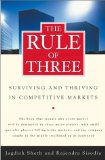 The Rule of Three: Surviving and Thriving in Competitive Markets
The Rule of Three: Surviving and Thriving in Competitive Markets
by Jagdish Sheth and Rajendra Sisodia
After reading this book, I realized that we are surrounded by so many things we take for granted. I discovered several deceptively simple but powerful principles and existing conditions that have been a part of my culture and environment for decades. What was both extremely interesting and, at the same time, unsettling was the fact that while these things were all around me, I had never noticed them. It makes me wonder how many other obvious principles, conditions, lessons, etc. are right under my nose and I have yet to discover them. It certainly makes tomorrow both exciting and challenging.
Let me share one of the obvious facts I learned from Sheth and Sisodia in The Rule of Three. Name any industry and more likely than not you will find that the three strongest, most efficient companies control 70% to 90% of the market. Consider these few examples:
- McDonald’s, Burger King, and Wendy’s (Burger Chains)
- General Mills, Kellogg, and Post (Cereal Companies)
- Nike, Adidas, and Reebok (Athletic Shoe Companies)
- Fortune, Forbes, and Business Week (Business Magazines)
- American, United, and Delta (Airlines)
- Hershey, Mars, and Nestle (Candy Makers)
- Visa, Mastercard, and American Express (Credit Card Networks)
- Duracell, Energizer, and Rayovac (Battery Makers)
- Wal-Mart, K-Mart, and Target (Discount Merchandisers)
- AT&T, MCI/Worldcom, and Sprint (Long Distance Carriers)
- Allstate, State Farm, and Farmers’ Group (Insurance Companies)
- Levi Strauss, Lee, and Wrangler (Jeans Makers)
- Carnival, Royal Caribbean, and Princess (Cruise Lines)
- Marriott, Hilton, and Sheraton (Hotel Chains)
The list goes on for pages. This book reveals why every market will be dominated by three major players, with small specialty players filling niche markets, and any company caught in the middle swallowed up and destroyed. True, there are a few examples where there are only two major competitors such as the soft drink market (Coke and Pepsi). However, efficiency’s favorite number is three: two companies would lead to monopoly pricing or mutual destruction, while four guarantees consistent price wars.
Markets tend to fall into two complementary sectors—”generalists” which cater to a large, mainstream group of customers; and “specialists” that successfully concentrate on niche products (such as high-end audio gear) or niche markets (like fashions for professional women) at both the high and low ends of the market. Any company caught in the middle (“the ditch”) is likely to be swallowed up or destroyed. The authors point out that most markets resemble a shopping mall with specialty shops anchored by large stores.
The authors examine this pattern of market evolution and the “radical disruption” that can occur when technology or regulation changes or a new entry “succeeds in altering the rules” (as Starbucks did by sneaking up on coffee’s Big Three). Of particular value is the detailed descriptions of the strategies that are most likely to succeed and fail, and the most frequent causes of those outcomes.
Make certain you have an ample supply of highlighters before turning your first page because regardless of your industry, the size of your business, or your ambitions, you will be well rewarded by the time you spend with this book.
(This book review was originally published in 2002 as one of the Top 10 Books – Edition 10.)
About Harry K. Jones
Harry K. Jones is a motivational speaker and consultant for AchieveMax®, Inc., a company of professional speakers who provide custom-designed seminars, keynote presentations, and consulting services. Harry's top requested topics include change management, customer service, creativity, employee retention, goal setting, leadership, stress management, teamwork, and time management. For more information on Harry's presentations, please call 800-886-2629 or fill out our contact form.
